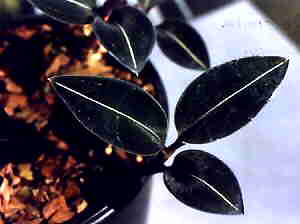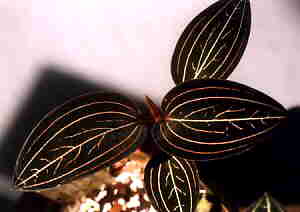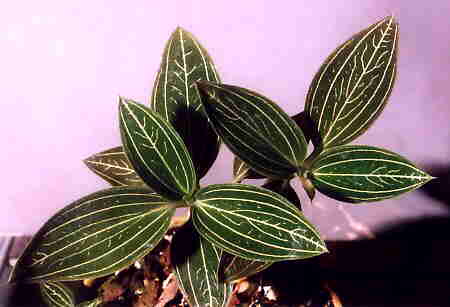|
|
|
CONTACT US
|
| This site is best viewed with a screen resolution of 800 X 600 at high colour settings |
|
Flask list
Acacallis-Ancistrochilus Angraecum-Aspasia Barkeria-Broughtonia Bulbophyllum Capanemia-Catasetum Cattleya Cattleyopsis-Cycnoch, Cymbidium-Cyrtorchis Dendrobium-Dossinia Encyclia-Eulophiella Galeandra-Jumellea Laelia-Lycaste Macodes-Nephalaphyll, Odontogloss,-Oncidium Paphiopedilum-Psychilis Rangaeris-Stenocoryne Tainia-Zygopetalum |
|
Plant list
Acampe-Bulbophyllum Cattleya-Dossinia Encyclia-Promeaea Renanthera-Vanda |

The jewel Ludisia
Several years ago, we self pollinated a plant that had arisen as a seedling in the bush house, most likely from seed from a natural selfing of the var Dawsoniana. This form was identified as Schlecter's var odina, with silver veins instead of the copper veins of var Dawsoniana.
At about the same time, we acquired a small plant of an alba form of the Ludisia. Alba in that the leaf was green with silver veining, with only a faint shadow of the normal red colouring under the leaf. This plant eventually flowered and was selfed. The seed was sown in flask but nothing germinated. However, shortly after, a swarm of seedlings appeared in pots near to where the alba form was growing. The seed was from an uncollected seed pod on the alba form plant.
The third form is also a plant that arose in an orchid collection from the natural dispersal of seed of var Dawsoniana. This form is of a sturdier plant, with yellowish green leaves that have copper coloured veins in the new leaf, and lightly flushed red underneath. When the leaves mature, the veining goes to a gold colour, on a background of yellowish green. Green gold would aptly describe this form. The flowers of all the forms were the same, white with the yellow spot. All the plants of Ludisia are grown in 85 to 90% shade, in small pots in a mixture of fine bark, shredded isolite and coconut peat, well crocked. They rest in winter and need less water at that time. When active growth begins, they like lots of water and fertiliser. The plants seem to like to hang over the side of their pot, and will develop into large clumps if allowed. One can imagine it growing in the wild as a semiterrestrial lithophyte, rooted into the rock crevices and sprawling over the rock face. There is nothing unusual in this natural variation, it is the hallmark of all orchid species, on their evolutionary way, regardless of those who sit and ponder and infinitely dissect orchid species down to a myriad of new names. |
Text and photographs by Ian Walters.
May be reproduced provided source acknowledged.
 A commonly grown orchid species is Ludisia (Haemaria) discolor, with two forms well established in cultivation. The variety Dawsoniana has a reddish leaf prominently veined with a copper colour, and the dark green black leaf, red underneath, centre silver stripe, is usually referred to as the type form. The flowers of both forms are identical.
A commonly grown orchid species is Ludisia (Haemaria) discolor, with two forms well established in cultivation. The variety Dawsoniana has a reddish leaf prominently veined with a copper colour, and the dark green black leaf, red underneath, centre silver stripe, is usually referred to as the type form. The flowers of both forms are identical.
 Seedlings raised from this in flask were predominently var odina, with some reverting to the type form with the single silver midrib vein. The leaf is a dark green, flushed, especially underneath, dark red. Most of the veining is silver, with the outer vein or two slightly coloured pink red.
Seedlings raised from this in flask were predominently var odina, with some reverting to the type form with the single silver midrib vein. The leaf is a dark green, flushed, especially underneath, dark red. Most of the veining is silver, with the outer vein or two slightly coloured pink red.
 Most of this swarm of seedlings developed into alba form plants, with about half of them showing a true alba condition, with leaves of clear green, veined silver, and no colouring at all under the leaf.
Most of this swarm of seedlings developed into alba form plants, with about half of them showing a true alba condition, with leaves of clear green, veined silver, and no colouring at all under the leaf.